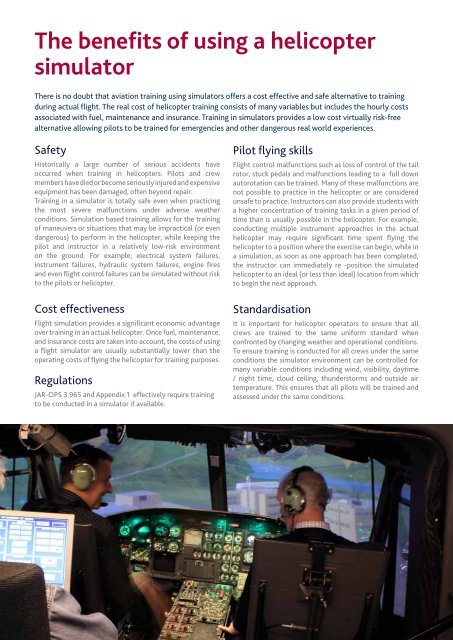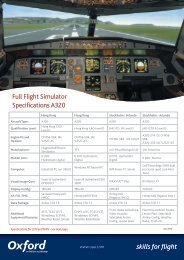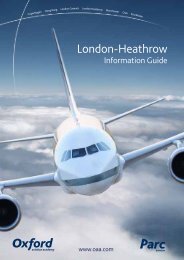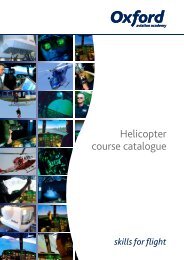Bell/AB 212/412 Helicopter SimulatorTraining - Oxford Aviation ...
Bell/AB 212/412 Helicopter SimulatorTraining - Oxford Aviation ...
Bell/AB 212/412 Helicopter SimulatorTraining - Oxford Aviation ...
You also want an ePaper? Increase the reach of your titles
YUMPU automatically turns print PDFs into web optimized ePapers that Google loves.
The benefits of using a helicopter<br />
simulator<br />
There is no doubt that aviation training using simulators offers a cost effective and safe alternative to training<br />
during actual flight. The real cost of helicopter training consists of many variables but includes the hourly costs<br />
associated with fuel, maintenance and insurance. Training in simulators provides a low cost virtually risk-free<br />
alternative allowing pilots to be trained for emergencies and other dangerous real world experiences.<br />
Safety<br />
Historically a large number of serious accidents have<br />
occurred when training in helicopters. Pilots and crew<br />
members have died or become seriously injured and expensive<br />
equipment has been damaged, often beyond repair.<br />
Training in a simulator is totally safe even when practicing<br />
the most severe malfunctions under adverse weather<br />
conditions. Simulation based training allows for the training<br />
of maneuvers or situations that may be impractical (or even<br />
dangerous) to perform in the helicopter, while keeping the<br />
pilot and instructor in a relatively low-risk environment<br />
on the ground. For example, electrical system failures,<br />
instrument failures, hydraulic system failures, engine fires<br />
and even flight control failures can be simulated without risk<br />
to the pilots or helicopter.<br />
Cost effectiveness<br />
Flight simulation provides a significant economic advantage<br />
over training in an actual helicopter. Once fuel, maintenance,<br />
and insurance costs are taken into account, the costs of using<br />
a flight simulator are usually substantially lower than the<br />
operating costs of flying the helicopter for training purposes.<br />
Regulations<br />
JAR-OPS 3.965 and Appendix 1 effectively require training<br />
to be conducted in a simulator if available.<br />
Pilot flying skills<br />
Flight control malfunctions such as loss of control of the tail<br />
rotor, stuck pedals and malfunctions leading to a full down<br />
autorotation can be trained. Many of these malfunctions are<br />
not possible to practice in the helicopter or are considered<br />
unsafe to practice. Instructors can also provide students with<br />
a higher concentration of training tasks in a given period of<br />
time than is usually possible in the helicopter. For example,<br />
conducting multiple instrument approaches in the actual<br />
helicopter may require significant time spent flying the<br />
helicopter to a position where the exercise can begin, while in<br />
a simulation, as soon as one approach has been completed,<br />
the instructor can immediately re -position the simulated<br />
helicopter to an ideal (or less than ideal) location from which<br />
to begin the next approach.<br />
Standardisation<br />
It is important for helicopter operators to ensure that all<br />
crews are trained to the same uniform standard when<br />
confronted by changing weather and operational conditions.<br />
To ensure training is conducted for all crews under the same<br />
conditions the simulator environment can be controlled for<br />
many variable conditions including wind, visibility, daytime<br />
/ night time, cloud ceiling, thunderstorms and outside air<br />
temperature. This ensures that all pilots will be trained and<br />
assessed under the same conditions.








